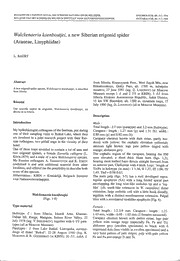
Walckenaeria koenboutjei, a new Siberian erigonid spider PDF
Preview Walckenaeria koenboutjei, a new Siberian erigonid spider
BULLETIN DE L'INSTITUT ROYAL DES SCIENCES NATURELLES DE BELGIQUE, ENTOMOLOGIE, 64:5-7, 1994 BULLETIN VAN HET KONINKLIJK BELGISCH INSTITUUT VOOR NATUURWETENSCHAPPEN, ENTOMOLOGIE, 64:5-7, 1994 Walckenaeria koenboutjei, a new Siberian erigonid spider (Araneae, Linyphiidae) L. BAERT Abstract from Siberia, Krasnoyarsk Prov., West Sayah Mts, near Ermakov'skoye, Oisky Pass, alt. 1700 m, subalpine A new erigonid spider species, Wa/ckenaeria koenboutjei, is described meadow, 27 june 1991 (leg. D. LOGUNOV) (at Moscow from Siberia. o oo Museum except 1 and 2 S?S? at KBIN); 3 from Siberia Khakass Autonomous Republic, Askir District, Resume 15 km SW Bizchikal, alt. 1300 m, mountain taiga, 17 July 1990 (leg. D. LoouNov) (all at Moscow Museum). Une nouvelle espece de erigonide, Walckenaeria koenboutjei, est decrite de Ia Siberie. Description Introduction Male: Total length: 2.7 mm (paratype) and 3.2 mm (holotype). My hydrobiologist colleagues of the Institute, put during Carapace : length: 1.27 mm (p) and 1.31 (h); width: one of their sampling visits to Baikal Lake, where they 0.89 mm (p) and 0.92 mm (h). are involved in a joint research project with their Rus Carapace chestnut brown with dark striae, partly bor sian colleagues, two pitfall traps in the vicinity of their dered with yellow; the cephalic elevation yellowish; hotel. sternum light brown; legs pale yellow tinged with One of these traps revealed to contain a lot of ants and orange; abdomen grey. two erigonid spiders, a female Zornella cultigera (L. The cephalic region of the carapace, bearing the PM KocH, 1879) and a male of a new Walckenaeria species. eyes elevated, a short thick blunt hom (figs. 1, 2), My Russian colleagues A. TANASEVITCH and K. EsKOV bearing short barbed hairs directs straight forward from confirmed it and sent additional material from other its anterior part. Chelicerae with 4 teeth. Legs : length of localities, and offered me the possibility to describe both Ti+Pa in holotype (in mm) : I 1.36, IT 1.27, III 1.06, IV sexes of the species. 1.43. Tml = 0.58-0.63. Abbreviation : KBIN = Koninklijk Belgisch Instituut The male palp (figs. 3-5) has a well developed supra voor Natuurwetenschappen. tegular apophysis (SA) with a long folded apical part envelopping the long wire-like embolus tip and a 'leg like' (cfr. trunk-like extension in W. cuspidata) distal extension; large embolic coil with a little hook distally; Walckenaeria koenboutjei tegulum with a distinct membraneous extension. Palpal (Figs. 1-9) tibia with a retrolateral toothlike apophysis (Fig. 6). Type material Female: Total length: 3.2-3.9 mm. Carapace: length: 1.27- o : Holotype from Siberia, Irkutsk Area, Khamar 1.43 mm, width : 0.95 - 1.03 mm (5 females measured). Dab~ Mt. Range, Manguta, Solzan River Valley, 22 Carapace chestnut brown with darker striae; legs pale July 1978 (leg. V. SHILENKOV), together with 6 S? S? para yellow with orange tinge (especially Fe, Pa and Ti); types (all at Moscow Museum). abdomen grey (swollen specimens) to black with 6 Paratypes : o from Lake Baikal, Listvianka, surroun impressed dots (less visible in swollen specimens) and a dings of Hotel 'Baikal'; 22-28 August 1990 (leg. K. very faint pattern of pale stripes; palp with pale yellow oo, o MARTENS & B. GODDEER!S) (at KBIN); 20 subA Fe and Pa and orange Ti and Ta. 6 L. BAERT 9 7 Figs. 1-9. - Walckenaeria koenboutjei, new species. 1. Headregion of male carapace, lateral view. 2. Male carapace, dorsal view. 3. Expanded male palp. 4. Male palp, ventral view. 5. Detail of embolus and suprategular apophysis. 6. Male palpal tibia, prolateral view. 7. Dorsal view of male palpal tibia and cymbium. 8. Epigynum, external ventral view. 9. Vulva, internal ventral view. (Scale lines : 0.1 mm). Walckenaeria koenboutjei, a new Siberian erigonid spider 7 Carapace with slightly elevated anterior and posterior the general external appearance of the epigynum and of parts; chelicerae robust with 5 rather long teeth. the dorsal plate. Legs : length of Ti+Pa (in mm): I 1.30-1.43, II 1.27- W. koenboutjei can for these reasons be placed in the 1.36, III 1.05-1.17, IV 1.36-1.47 (4 specimens mea cuspidata-group, according to MrLLmGE (1983), or in sured). the Heteroprosopotheca subgenus according to WUN Epigyne resembling exteriorely the epigyne of W. cuspi DERLICH (1972). data; spermathecae strongly coiled, arranged as a X (Figs. 8, 9). Acknowledgements Etymology I wish to thank Drs A. TANASEVITCH and K. ESKOY (Moscow) for the information they gave and the mate This species is named after the two Belgian hydrobiolo rial they lend, and Eliane DEBOCK for the final ink gists, Boudewijn (boutje) Goddeeris and Koen Martens, drawings. who collected the Baikal specimen during a BICER mission to lake Baikal. Bibliography Diagnosis MILLIDGE, A.F., 1983. The erigonine spiders of North Ameri ca. Part 6. The genus Walckenaeria Blackwall (Araneae, The male of W. koenboutjei is diagnosed by the form of Linyphiidae). The Journal of Arachnology, II : 105-200. the cephalic region, the palpal tibia and the structure of the palpal organ. The female is diagnosed by the epi WUNDERLICH, J., 1972. Zur Kenntnis der Gattung Walckenae ria Blackwall 1833 unter besonderer Beriicksichtigung der gynal dorsal plate and the coiled spermathecae. europaischen Subgenera und Arten (Arachnida : Araneae : W. koenboutjei sp. n. seems to be closest to W. cuspidata Linyphiidae). Zoologische Beitrage, 18 (3) : 371-427. (BLACKWALL, 1833) according to the following charac teristics of the male palp and female epigynum : (1) the L. BAERT SA has a distal extension, 'trunk-like' in W. cuspidata Department of Entomology and 'leg-like' in W. koenboutjei; (2) both have a fairly K.B.I.N., Vautierstraat 29 large embolic coil; (3) the form of the palpal tibia; (4) B-10 40 Brussels
